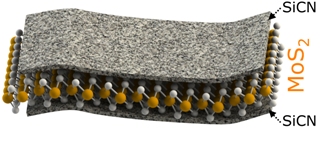Apr 20 2015
A mechanical engineering research team from Kansas State University has discovered the solution to better cellphones and other rechargeable electronic gadgets by forming tiny nanosheet ‘sandwiches’.
 A mechanical engineering research team from Kansas State University has discovered the solution to better cellphones and other rechargeable electronic gadgets by forming tiny nanosheet ‘sandwiches’.
A mechanical engineering research team from Kansas State University has discovered the solution to better cellphones and other rechargeable electronic gadgets by forming tiny nanosheet ‘sandwiches’.
The team, headed by Gurpreet Singh, assistant professor of mechanical and nuclear engineering, took up a project to improve rechargeable lithium-ion batteries with special focus on the lithium cycling of molybdenum disulfide, or MoS2, sheets. Singh labels these sheets as a ‘sandwich’ comprising of one molybdenum atom in the middle of two sulfur atoms.
Their current findings are that silicon carbonitride-wrapped molybdenum disulfide sheets displayed better stability as a battery electrode with minimal fading of capacity.
Their research findings were published in Nature's Scientific Reports in the article "Polymer-Derived Ceramic Functionalized MoS2 Composite Paper as a Stable Lithium-Ion Battery Electrode." Other Kansas State University researchers involved include Lamuel David, doctoral student in mechanical engineering, India; Uriel Barrera, senior in mechanical engineering, Olathe; and Romil Bhandavat, 2013 doctoral graduate in mechanical engineering.
In this publication, the Kansas State University team explained that molybdenum disulfide sheets are capable of storing more than double the amount of lithium or charge than bulk molybdenum disulfide. The researchers however observed that the sheets’ high lithium capacity was not long-lasting and decreased after five charging cycles.
"This kind of behavior is similar to a lithium-sulfur type of battery, which uses sulfur as one of its electrodes," Singh said. "Sulfur is notoriously famous for forming intermediate polysulfides that dissolve in the organic electrolyte of the battery, which leads to capacity fading. We believe that the capacity drop observed in molybdenum disulfide sheets is also due to loss of sulfur into the electrolyte."
The researchers wrapped the molybdenum disulfide sheets with a few layers of a ceramic known as silicon carbonitride, or SiCN, so as to minimize the dissolution of sulfur-based items into the electrolyte.
Singh explained that ceramic, being a high-temperature, glassy material prepared by heating liquid silicon-based polymers, was capable of better chemical resistance against the liquid electrolyte.
"The silicon carbonitride-wrapped molybdenum disulfide sheets show stable cycling of lithium-ions irrespective of whether the battery electrode is on copper foil-traditional method or as a self-supporting flexible paper as in bendable batteries," Singh said.
The cells were dissembled and analyzed by the research team under an electron microscope following the reactions. They confirmed that the silicon carbonitride acted as a protection against chemical and mechanical degeneration with liquid organic electrolyte.
Singh’s team followed up on the behavior of molybdenum disulfide cells in everyday electronic gadgets like cellphones which require recharging many times. They plan to further dwell on the molybdenum disulfide cells during recharging cycles so as to gather more data to better test and understand ways to enhance rechargeable batteries.
The other research by the team will assist in developing better high temperature coatings for the defense and aerospace sector. Singh’s team is working on creating a coating material with the capability of protecting electrode materials against tough environments, such as metals and turbine blades exposed to extreme heat.
The research findings were published in the Journal of Physical Chemistry. Singh’s team revealed that when boron nitride nanosheets and silicon carbonitride are integrated, they produce better electrical conductivity and high temperature stability. Singh added that the silicon carbonitride/boron nitride nanosheets made better battery electrodes as well.
"This was quite surprising because both silicon carbonitride and boron nitride are insulators and have little reversible capacity for lithium-ions," Singh said. "Further analysis showed that the electrical conductivity improved because of the formation of a percolation network of carbon atoms known as 'free carbon' that is present in the silicon carbonitride ceramic phase. This occurs only when boron nitride sheets are added to silicon carbonitride precursor in its liquid polymeric phase before curing is achieved."
The researchers received support from the National Science Foundation for both the projects.